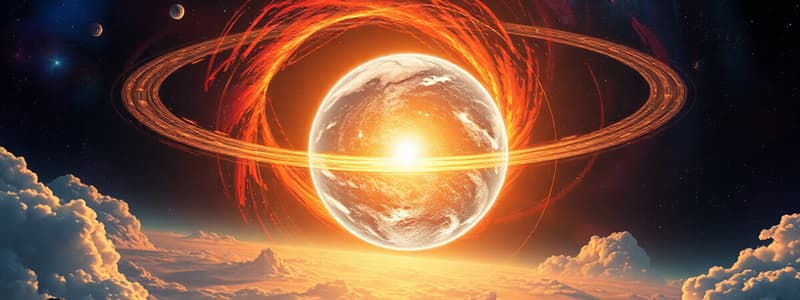Podcast
Questions and Answers
What is the most abundant gas in the composition of air?
What is the most abundant gas in the composition of air?
- Carbon Dioxide
- Argon
- Nitrogen (correct)
- Oxygen
Which component of air is primarily responsible for cloud formation and precipitation?
Which component of air is primarily responsible for cloud formation and precipitation?
- Methane
- Ozone
- Water Vapor (correct)
- Carbon Dioxide
What percentage of the air's composition is made up of carbon dioxide?
What percentage of the air's composition is made up of carbon dioxide?
- 14.8%
- 21.014%
- 0.030% (correct)
- 0.901%
Which gas is known for absorbing harmful UV radiation in the atmosphere?
Which gas is known for absorbing harmful UV radiation in the atmosphere?
Which pollutant constitutes the highest percentage of primary pollutants from transportation?
Which pollutant constitutes the highest percentage of primary pollutants from transportation?
What is the tilt of the Earth in degrees?
What is the tilt of the Earth in degrees?
How long does it take for the Earth to revolve around the Sun?
How long does it take for the Earth to revolve around the Sun?
What phenomenon causes day and night on Earth?
What phenomenon causes day and night on Earth?
In which direction does the Earth rotate?
In which direction does the Earth rotate?
What is the primary reason for leap years?
What is the primary reason for leap years?
What is the term used for when Earth is closest to the sun?
What is the term used for when Earth is closest to the sun?
Which of the following correctly describes how seasons are caused?
Which of the following correctly describes how seasons are caused?
What does the celestial equator represent?
What does the celestial equator represent?
What happens at aphelion in Earth's orbit?
What happens at aphelion in Earth's orbit?
Which of these statements about Earth's orbit is true?
Which of these statements about Earth's orbit is true?
What is the main reason for the seasons on Earth?
What is the main reason for the seasons on Earth?
At what angle is the Earth's axis tilted relative to its orbital plane?
At what angle is the Earth's axis tilted relative to its orbital plane?
How does the angle of the sun affect heating on Earth?
How does the angle of the sun affect heating on Earth?
Which of the following describes an effect of a low angle of the sun?
Which of the following describes an effect of a low angle of the sun?
What phenomenon occurs during the solstices?
What phenomenon occurs during the solstices?
What is the date of the Vernal Equinox?
What is the date of the Vernal Equinox?
What phenomenon occurs during an equinox?
What phenomenon occurs during an equinox?
Where does sunlight strike the Earth most directly during an equinox?
Where does sunlight strike the Earth most directly during an equinox?
What is the meaning of the term 'equinox'?
What is the meaning of the term 'equinox'?
What phenomenon occurs twice a year when the tilt of the Earth's axis is oriented directly towards or away from the Sun?
What phenomenon occurs twice a year when the tilt of the Earth's axis is oriented directly towards or away from the Sun?
Which of the following latitudes is NOT indicated in the diagram?
Which of the following latitudes is NOT indicated in the diagram?
During which solstice does the North pole experience 24 hours of daylight?
During which solstice does the North pole experience 24 hours of daylight?
What is happening at the Equinoxes?
What is happening at the Equinoxes?
Why is summer warmer than winter in each hemisphere?
Why is summer warmer than winter in each hemisphere?
When does the Vernal Equinox occur?
When does the Vernal Equinox occur?
What is the significance of water vapor in the atmosphere?
What is the significance of water vapor in the atmosphere?
What must occur for water to transition from a solid to a liquid state?
What must occur for water to transition from a solid to a liquid state?
What defines the energy required for water to change from a liquid to a gas?
What defines the energy required for water to change from a liquid to a gas?
Which statement about latent heat is correct?
Which statement about latent heat is correct?
Which condition is essential for the process of evaporation to occur?
Which condition is essential for the process of evaporation to occur?
What is the process called when water vapor changes back into a liquid state?
What is the process called when water vapor changes back into a liquid state?
What is released during condensation that is crucial for weather phenomena?
What is released during condensation that is crucial for weather phenomena?
What is the term used to describe the amount of water vapor present in the air?
What is the term used to describe the amount of water vapor present in the air?
Which of the following describes the process of a solid turning directly into a gas?
Which of the following describes the process of a solid turning directly into a gas?
What type of humidity measurement indicates the temperature at which air becomes saturated with moisture?
What type of humidity measurement indicates the temperature at which air becomes saturated with moisture?
Flashcards
Air Composition
Air Composition
Air is a mix of gases and particles, each with unique properties.
Major Air Gases
Major Air Gases
Nitrogen (78%), Oxygen (21%), and Argon (0.9%), along with trace amounts of other gases constitute the majority of air.
Water Vapor's role in Atmosphere
Water Vapor's role in Atmosphere
Water vapor is essential for clouds and precipitation. It absorbs heat from the Earth and the sun.
Ozone's Function
Ozone's Function
Signup and view all the flashcards
Transportation Pollution
Transportation Pollution
Signup and view all the flashcards
Earth's Rotation
Earth's Rotation
Signup and view all the flashcards
Earth's Axis Tilt
Earth's Axis Tilt
Signup and view all the flashcards
Earth's Revolution
Earth's Revolution
Signup and view all the flashcards
Leap Year
Leap Year
Signup and view all the flashcards
Rotation Direction
Rotation Direction
Signup and view all the flashcards
Earth's orbit
Earth's orbit
Signup and view all the flashcards
Perihelion
Perihelion
Signup and view all the flashcards
Aphelion
Aphelion
Signup and view all the flashcards
Celestial Equator
Celestial Equator
Signup and view all the flashcards
Ecliptic
Ecliptic
Signup and view all the flashcards
Seasons cause
Seasons cause
Signup and view all the flashcards
Low angle sun
Low angle sun
Signup and view all the flashcards
High angle sun
High angle sun
Signup and view all the flashcards
Earth's tilt
Earth's tilt
Signup and view all the flashcards
Earth's revolution
Earth's revolution
Signup and view all the flashcards
Vernal Equinox
Vernal Equinox
Signup and view all the flashcards
Autumnal Equinox
Autumnal Equinox
Signup and view all the flashcards
Equinox
Equinox
Signup and view all the flashcards
Sunlight at Equinox
Sunlight at Equinox
Signup and view all the flashcards
Equator
Equator
Signup and view all the flashcards
Solstice
Solstice
Signup and view all the flashcards
Condensation
Condensation
Signup and view all the flashcards
Sublimation
Sublimation
Signup and view all the flashcards
Summer Solstice
Summer Solstice
Signup and view all the flashcards
Latent heat of condensation
Latent heat of condensation
Signup and view all the flashcards
Winter Solstice
Winter Solstice
Signup and view all the flashcards
Equinox
Equinox
Signup and view all the flashcards
Humidity
Humidity
Signup and view all the flashcards
Relative humidity
Relative humidity
Signup and view all the flashcards
Vernal Equinox
Vernal Equinox
Signup and view all the flashcards
Water's States
Water's States
Signup and view all the flashcards
Water Cycle
Water Cycle
Signup and view all the flashcards
Latent Heat
Latent Heat
Signup and view all the flashcards
Evaporation
Evaporation
Signup and view all the flashcards
Latent Heat of Evaporation
Latent Heat of Evaporation
Signup and view all the flashcards




